Ball Python
P. regius
Advertisement
Ball Python Scientific Classification
- Kingdom
- Animalia
- Phylum
- Chordata
- Class
- Reptilia
- Order
- Squamata
- Family
- Pythonidae
- Genus
- Python
- Scientific Name
- P. regius
Read our Complete Guide to Classification of Animals.
Ball Python Conservation Status
Ball Python Facts
- Common Name
- ball python
View all of the Ball Python images!
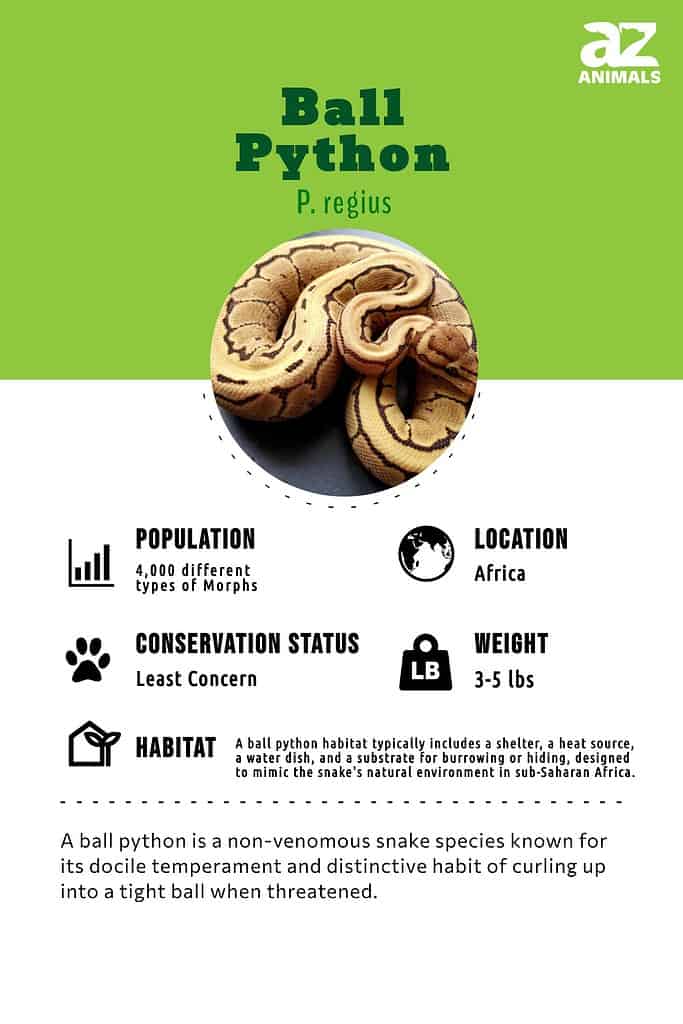
The ball python is one of the 10 species that are in the genus Python. The genus is made up of constricting species in the Pythonidae family that live in the tropical and subtropical areas of the Eastern Hemisphere.
The ball python female lays up to 11 eggs and coils around them to keep them warm. The eggs are incubated for around 2 months. Once they hatch, the baby ball pythons are immediately independent. Despite their small size, which is less than 17 inches, they are capable of hunting on their own.
As the snake matures, its color pattern becomes less vivid. It will remain close to where it was hatched for a few months and gradually range into a larger area as it matures.
Ball Python Amazing Facts
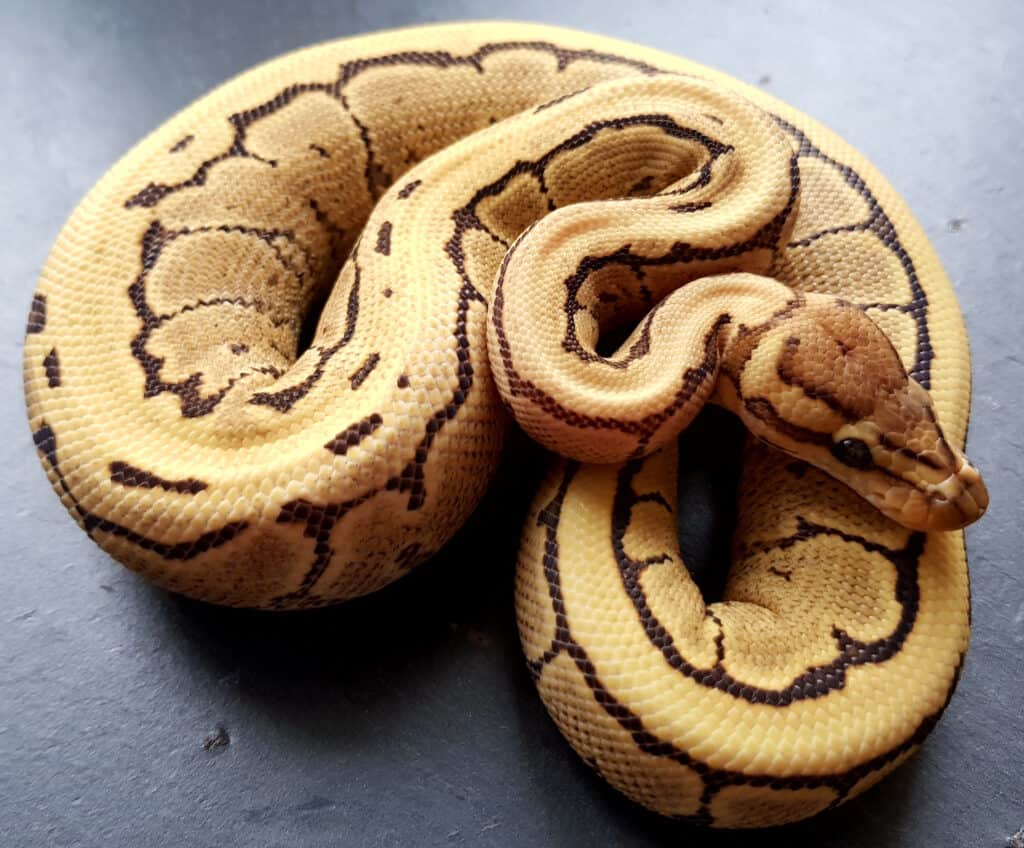
Like other ball pythons, desert ghost ball pythons have thick stocky bodies and triangular heads.
©Deb Davis/Shutterstock.com
- They are the most popular snake species among those kept as pets
- The baby ball python is born completely independent
- A healthy baby is less than 17 inches long and brightly colored
- Every ball python has a unique pattern, like fingerprints on humans
Where To Find the Ball Python
Native to Sub-Saharan Africa, the ball python prefers savannas, grasslands, and lightly wooded areas. Ball pythons purchased as pets do better when born and raised in captivity. Wild-caught ball pythons often carry both internal and external parasites, and many never learn to eat well in captivity.
Evolution and Origins
The ball python has been found in at least 18 different nations and is a native of the open woodlands and savannahs of western Africa south of the Sahara, ranging east into northwestern Uganda.
The last time pythons and boas had a common ancestor was during the time of the dinosaurs, 70 million years ago. The study concentrated on the skull shapes of nearly 2,000 specimens in Australian and American museum collections.
The majority hypothesis holds that these cold-blooded, slithering, legless creatures descended from small, burrowing, land-dwelling lizards, or perhaps the mosasaur family of marine reptiles, which first appeared in the earth’s oceans some 100 million years ago.
Ball Python Scientific Name
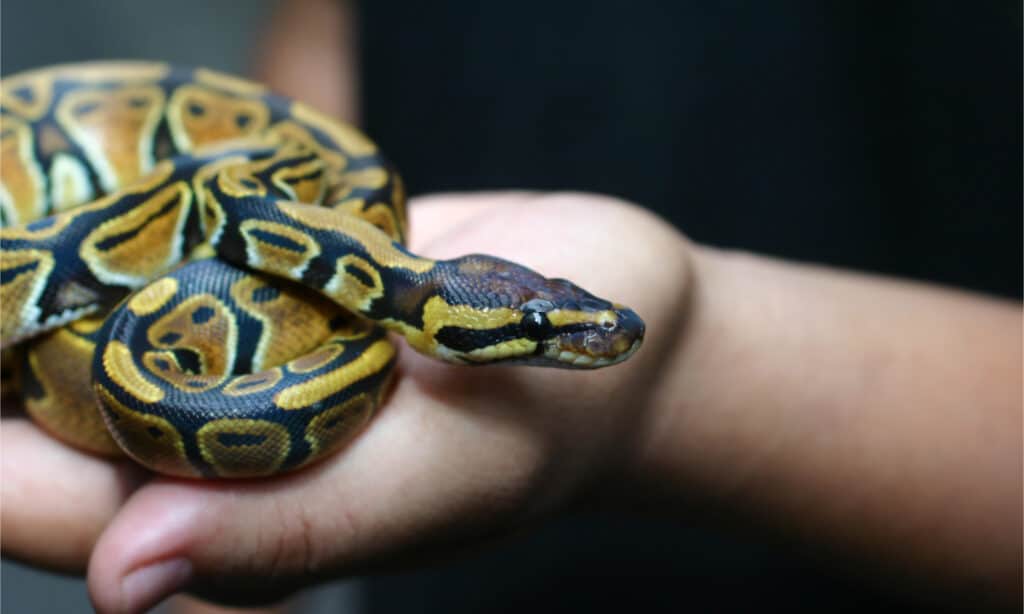
Beginner and popular snake for kids, Ball python (python regius) crawling on hand with selective focus and copy space, Background for exotic pets or animals, and wildlife concept
©Krisda Ponchaipulltawee/Shutterstock.com
The ball python’s scientific name is Python regius, from the class Reptilia and family Pythonidae. The scientific name Python regius translates to royal python. One of the most interesting facts about the snake is where its name originated. The ancient story is that Queen Cleopatra wore one of these snakes around her wrist for ornamentation.
Ball Python Population and Conservation Status
According to IUCN, the ball python is considered near threatened, with a declining population. Habitat changes due to humans and agriculture, loss of habitat, and poaching are all to blame for the declining numbers of ball pythons found in the wild.
Appearance and Description
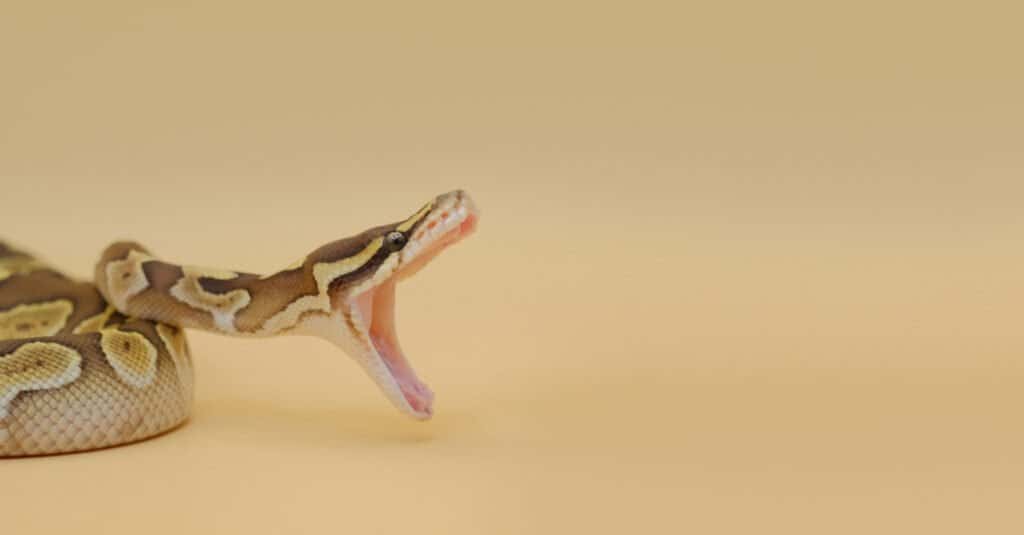
Ball pythons are non-venomous.
©Hand Robot/Shutterstock.com
Ball pythons come in a range of color combinations, known as morphs. One of the most fascinating facts about the ball python is the number of available morphs. It is estimated that over 4,000 morphs are available in captive-bred snakes. Some common colors and morphs include albino, banana, piebald, bumblebee, and lemon blast.
The albino ball python is white over the majority of its body, with yellow markings. The eyes are red or pink. The albino morph is typically one of the smaller size ball pythons, averaging between 3 and 5 feet in length, and has a calm temperament. These traits make it a great choice for new snake owners.
The banana ball python has a yellow base color, with lighter and darker spots across the body. The darkest spots can appear tan, while the lightest may seem almost white. Another docile and friendly morph, the banana ball python is a good choice for pet owners who enjoy handling their snakes.
The lemon blast morph is striking in appearance. The top of the body is yellow and the underbelly is white. The lemon blast also has a pinstripe marking that weaves across the top of the body. They have pale green or amber eyes.
The bumblebee morph is an eyecatching snake. With a bright yellow body and intricate black or brown markings, it is easy to see where the bumblebee got its name. Unlike the lemon blast morph, the bumblebee has dark eyes.
The piebald ball python carries a recessive trait that leads to areas of unpigmented color on its body. Typically the head is normally looking, and the body will have varying degrees of unpigmented sections. The piebald trait can show up on a variety of different morphs, overlaying the typical pattern with areas of unpigmented skin.
Ball Python Venom: How Dangerous Are They?
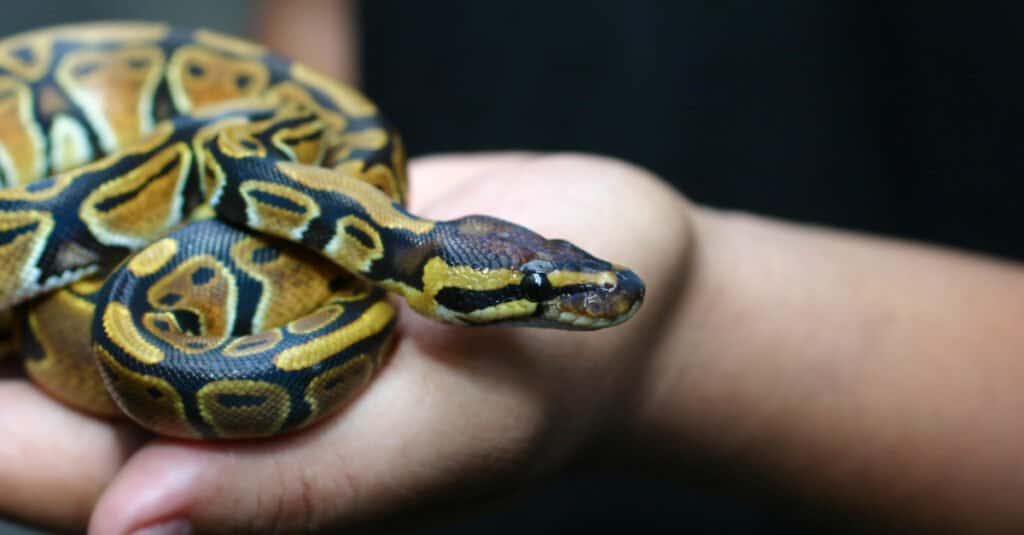
Ball pythons are popular “starter” snake pets.
©Krisda Ponchaipulltawee/Shutterstock.com
Ball pythons are non-venomous and generally not aggressive. Most ball pythons prefer to retreat when threatened. They will coil into a tight ball, with their head protected in the center when they feel cornered.
Although not venomous, bites from ball pythons can be painful. With around 150 teeth that are hooked-shaped, a bite can cause pain, swelling, and redness around the wound, as well as nausea, sweating, and tingling in the extremities.
Behavior and Humans
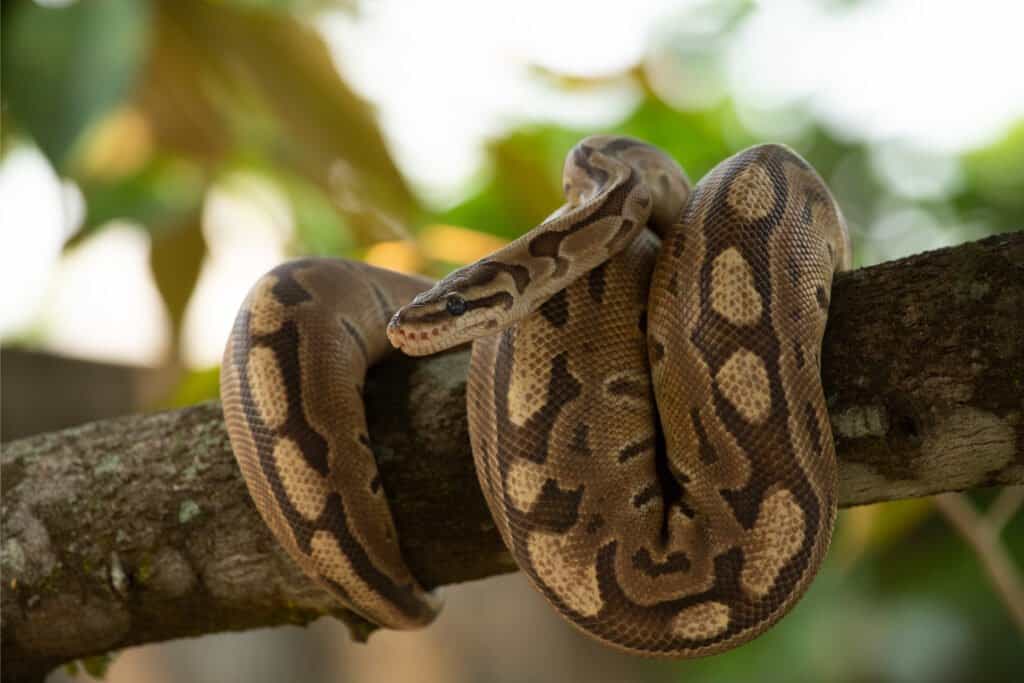
Ball pythons are not venomous.
©BikerPhoto/Shutterstock.com
In the wild, ball pythons are not confrontational. They prey on rats, mice, and other rodents, which makes them beneficial to those involved in agriculture. They are sometimes still killed due to fear, and chemicals involved in agriculture can also have a negative impact on them.
As a pet, the ball python is calm and curious, making it a good choice for novice snake owners.
View all 284 animals that start with BBall Python FAQs (Frequently Asked Questions)
Are ball pythons venomous?
No
How do ball pythons hunt?
Ball pythons hunt by ambush. They can remain still for hours or even days, waiting for prey to come within reach. Then, they rapidly strike, grasping the prey with their sharp, hook-shaped teeth. Depending on the size of their prey, they may swallow it whole immediately or use their body to constrict it, immobilizing it before they consume it.
Are ball pythons aggressive?
Generally, no. If you have a pet ball python and it becomes aggressive, it may be a sign that something else is going on. Common reasons why a ball python may become aggressive are because it is feeling stressed, perhaps from being in a new environment, or due to hunger.
Where do ball pythons live?
Ball pythons live in the sub-Saharan countries on the western side of Africa. They prefer living in relatively open grasslands and are often found in areas cleared for farming. Lightly forested areas also provide the habitat required for the ball python to thrive.
What do ball pythons eat?
As an ambush hunter and carnivore, the ball python dines on small mammals, such as rats, as well as birds.
Do ball pythons bite?
They may bite when they feel threatened, but they are generally calm and avoid confrontation.
Are ball python snakes friendly?
Their calm personalities make ball pythons excellent pets once they become accustomed to being handled. Short, frequent sessions will help the ball python become more comfortable, and most will quickly become comfortable and even friendly, looking forward to the interaction with their handler.
How big do ball python snakes get?
Up to 6 feet long, with females averaging a little longer than males.
What is the difference between a male and a female ball python?
The primary difference between male ball pythons and female ball pythons of the same age range is their size.
What are the differences between ball python and Burmese python?
The biggest differences between a Burmese python and a ball python lie in their size and color.
Thank you for reading! Have some feedback for us? Contact the AZ Animals editorial team.


















